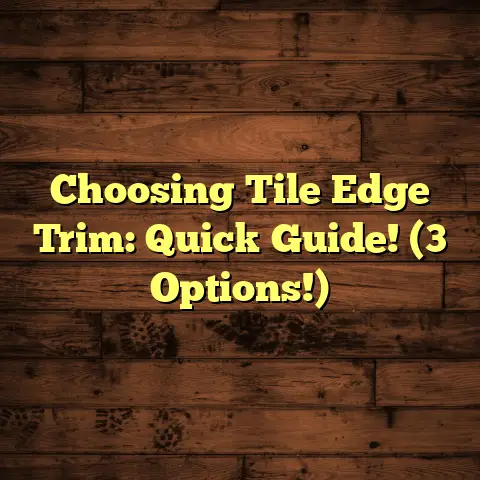How To Close Floor Gaps? (1-Day Fix!)
Are you tired of tripping over unsightly gaps in your flooring that seem to appear out of nowhere, wasting precious time on cleaning and maintenance?
I get it. It’s frustrating!
Floor gaps are a common headache.
They can
pop up due to temperature changes, humidity
fluctuations, or even just the natural
settling of your house.
Not only are they an eyesore, but they can also impact the safety and overall look of your home.
But don’t worry, I’m here to tell you that
you can tackle this problem quickly and
effectively.
And yes, you can often achieve
a fix in just one day!
In this article, I’m going to walk you through everything you need to know to close those pesky floor gaps.
I’ll cover the causes, how to assess the damage, the right tools and materials, and a step-by-step guide for different flooring types.
Let’s get started and make your floors beautiful and safe again!
Section 1: Understanding Floor Gaps
Okay, so what exactly are floor gaps?
Simply put, they’re those unwanted spaces
that appear between your flooring materials.
They can show up in a few different places:
- Between planks: This is common with hardwood or laminate flooring.
- At the edges: You might see gaps along the baseboards or walls.
- Between different flooring materials: For example, where your tile meets your carpet.
Why Do These Gaps Form?
There are several reasons why floor gaps
appear.
Here are some of the most common:
Environmental Factors: Temperature and humidity play a HUGE role.
Wood and laminate expand and contract with changes in moisture levels.
According to the Forest Products Laboratory, wood can expand or contract up to 5% across the grain depending on humidity levels.
This constant movement can lead to gaps.Installation Issues: Improper installation is a big culprit.
If the flooring wasn’t installed correctly with the right spacing or adhesives, gaps are more likely to form.Natural Wear and Tear: Over time, all flooring materials experience wear and tear.
This can cause them to shift, crack, or separate, leading to gaps.
Consequences of Ignoring Floor Gaps
Leaving floor gaps unaddressed can lead to
more than just aesthetic problems.
Here’s
why it’s important to fix them:
Pest Infestations: Gaps provide a cozy home for insects and other pests.
Termites, ants, and spiders can easily crawl into these spaces, leading to bigger infestations.Moisture Problems: Gaps allow moisture to seep under your flooring, which can cause mold, mildew, and rot.
This is especially problematic in bathrooms and kitchens.Aesthetic Concerns: Let’s face it, floor gaps just look bad.
They can make your home look old, neglected, and less valuable.
Section 2: Assessing Your Flooring Type
Before you start fixing anything, it’s
crucial to know what kind of flooring you’re
dealing with.
Each type requires a different
approach.
Here are some common flooring types and how they experience gaps:
Hardwood: Hardwood is very susceptible to changes in humidity.
Gaps between planks are common, especially in older homes.-
Laminate: Laminate is more stable than hardwood, but it can still develop gaps, especially if it’s not installed properly.
Tile: Gaps in tile usually occur in the grout lines.
This can happen due to wear and tear or improper installation.-
Vinyl: Vinyl flooring is generally water-resistant, but gaps can still form at the seams or edges, especially in sheet vinyl.
How to Assess the Severity of the Gaps
Take a close look at the gaps.
Are they small
and hairline, or are they wide enough to
stick your finger in?
Here’s a simple guide:
-
Hairline Gaps (Less than 1/8 inch): These are usually cosmetic and can be easily fixed with fillers or caulk.
-
Medium Gaps (1/8 to 1/4 inch): These might indicate a more significant problem, like subfloor issues or improper installation.
Large Gaps (Over 1/4 inch): These definitely need professional attention.
They could indicate structural problems or serious moisture damage.
Cosmetic vs. Structural Gaps
It’s important to determine if the gaps are just cosmetic or if they’re a sign of a bigger issue.
Cosmetic Gaps: These are usually small and don’t affect the stability of the floor.
They’re mainly an aesthetic concern.Structural Gaps: These are wider and may be accompanied by other problems, like uneven floors, squeaking, or bouncing.
These gaps indicate a problem with the subfloor or the structure of the house.
If you suspect structural issues, it’s best to call in a professional.
Section 3: Tools and Materials Needed for the Fix
Alright, let’s get down to the nitty-gritty.
Here’s a list of the essential tools and
materials you’ll need, depending on your
flooring type:
For Hardwood Floors:
Wood Filler: Choose a color that matches your flooring as closely as possible.
I prefer using stainable wood filler so I can customize the color.-
Putty Knife: For applying the wood filler smoothly.
-
Sandpaper: Various grits (120, 220) for smoothing the filled areas.
-
Stain: To match the existing color of your hardwood. Minwax is a reliable brand.
-
Polyurethane Finish: To protect the repaired area.
For Laminate Floors:
-
Gap Filler or Caulk: Look for a color- matched laminate gap filler.
-
Caulking Gun: For applying the filler neatly.
-
Damp Cloth: For wiping away excess filler.
For Tile Floors:
-
Grout Removal Tool: If you need to remove old grout.
-
New Grout or Caulk: Choose a color that matches your existing grout.
-
Grout Float: For applying the grout evenly.
-
Sponge: For cleaning up excess grout.
For Vinyl Floors:
-
Adhesive Strips or Seam Sealer: Depending on the size and location of the gap.
-
Utility Knife: For trimming the adhesive strips.
-
Seam Roller: For pressing the adhesive firmly.
Where to Purchase Materials
You can find these materials at most home improvement stores like:
- Home Depot
- Lowe’s
- Ace Hardware
You can also order online from retailers like Amazon.
Helpful Brands and Products
Here are some brands and products I’ve had good experiences with:
- Wood Filler: Elmer’s Carpenter’s Wood Filler
- Laminate Gap Filler: Color Rite
- Grout: Mapei Keracolor U
- Seam Sealer: Roberts 8015 Seam Sealer
Section 4: Step-by-Step Guide to Closing Floor Gaps
Okay, now for the fun part!
Let’s walk
through the process of closing floor gaps,
step-by-step, for each flooring type.
For Hardwood Floors:
Clean the Gaps Thoroughly: Use a vacuum cleaner or a small brush to remove any dirt, dust, or debris from the gaps.
A clean surface is essential for the filler to adhere properly.Apply Wood Filler with a Putty Knife: Take a small amount of wood filler and press it firmly into the gap.
Overfill the gap slightly, as the filler will shrink as it dries.
I like to use a flexible putty knife for this, as it allows me to get into tight spaces.Allow to Dry and Sand Smooth: Let the wood filler dry completely, according to the manufacturer’s instructions.
Once dry, use sandpaper to smooth the surface.
Start with a coarser grit (120) and finish with a finer grit (220) for a seamless blend.Stain or Finish to Match: Apply stain to the filled area to match the existing color of your hardwood.
You might need to experiment with different stain colors to get a perfect match.
Once the stain is dry, apply a coat of polyurethane finish to protect the repaired area.
For Laminate Floors:
-
Clean the Gaps: Use a vacuum cleaner or a damp cloth to remove any dirt or debris from the gaps.
Apply Gap Filler or Caulk: Load the gap filler or caulk into a caulking gun.
Apply a thin, even bead of filler along the gap.Smooth the Surface and Allow to Cure: Use your finger or a damp cloth to smooth the surface of the filler.
This will help it blend in with the surrounding laminate.
Allow the filler to cure completely, according to the manufacturer’s instructions.
For Tile Floors:
Remove Old Grout (If Necessary): If the existing grout is cracked or crumbling, you’ll need to remove it before applying new grout.
Use a grout removal tool to carefully scrape out the old grout.Apply New Grout or Caulk: Mix the grout according to the manufacturer’s instructions.
Use a grout float to press the grout into the gaps.Clean Excess and Allow to Dry: Use a damp sponge to wipe away any excess grout from the tile surface.
Allow the grout to dry completely, according to the manufacturer’s instructions.
For Vinyl Floors:
Assess the Gap and Choose Appropriate Adhesive: For small gaps, adhesive strips may be sufficient.
For larger gaps, you might need to use a seam sealer.Apply Adhesive Strips or Seam Sealer: If using adhesive strips, cut them to the appropriate length and apply them to the gap.
If using seam sealer, apply a thin bead along the gap.Press Down Firmly and Allow to Set: Use a seam roller to press down firmly on the adhesive.
This will ensure a strong bond.
Allow the adhesive to set completely, according to the manufacturer’s instructions.
Section 5: Quick Fixes for Temporary Solutions
Sometimes, you need a quick fix while you
plan a more permanent solution.
Here are a
few temporary options:
-
Rugs or Mats: Covering the gaps with rugs or mats is a simple and effective way to hide them.
-
Furniture Placement: Strategically place furniture to conceal the gaps.
Temporary Gap Fillers: There are products available that can serve as immediate gap fillers or disguises.
These are usually foam or rubber strips that can be easily inserted into the gaps.
Section 6: Preventive Measures to Avoid Future Gaps
Prevention is always better than cure!
Here
are some tips to help you avoid future floor
gaps:
Maintain Humidity Levels: Keep the humidity levels in your home consistent.
Use a humidifier or dehumidifier to regulate moisture.
According to the EPA, maintaining indoor humidity between 30-50% can prevent many problems.Use Proper Underlayment: When installing new flooring, use a high-quality underlayment.
This will help to stabilize the flooring and prevent gaps from forming.Regular Maintenance Checks: Inspect your floors regularly for any signs of gaps or damage.
Catching problems early can prevent them from becoming bigger issues.Seasonal Checks: Perform seasonal checks to catch any emerging gaps early.
Pay special attention during the winter months when humidity levels are low.
Conclusion
So, there you have it!
Closing floor gaps
doesn’t have to be a daunting task.
With
the right materials and methods, you can
achieve a quick and effective fix in just
one day.
Remember to assess your flooring type, gather the necessary tools and materials, and follow the step-by-step guides I’ve provided.
Don’t let those unsightly gaps ruin the
beauty and safety of your home.
Take action
today and implement the steps I’ve shared to
enhance the appearance and longevity of your
floors.
Home maintenance is an ongoing process, but
the satisfaction that comes from DIY repairs
is well worth the effort.
So, roll up your
sleeves, get to work, and enjoy the feeling
of accomplishment that comes with a job well
done!





